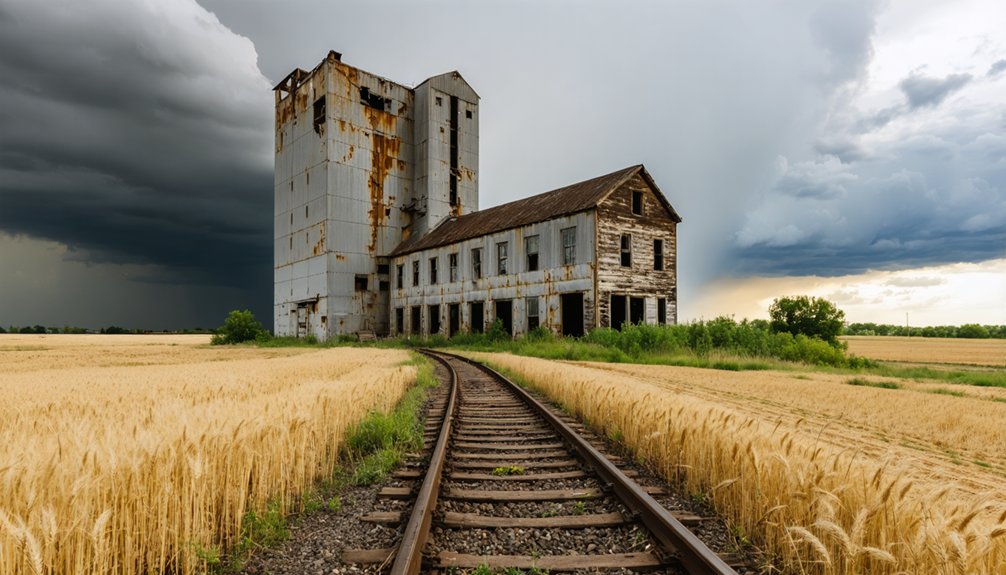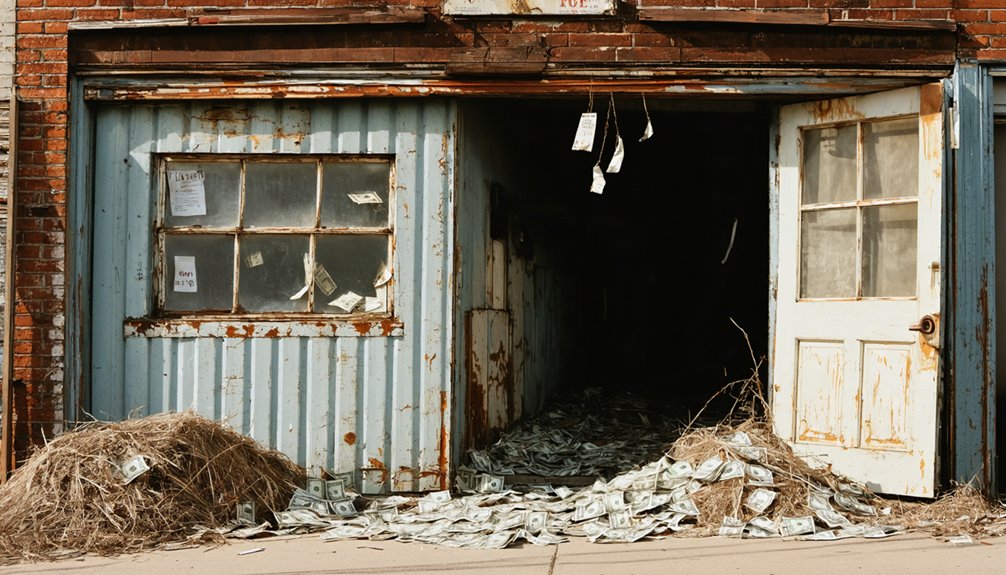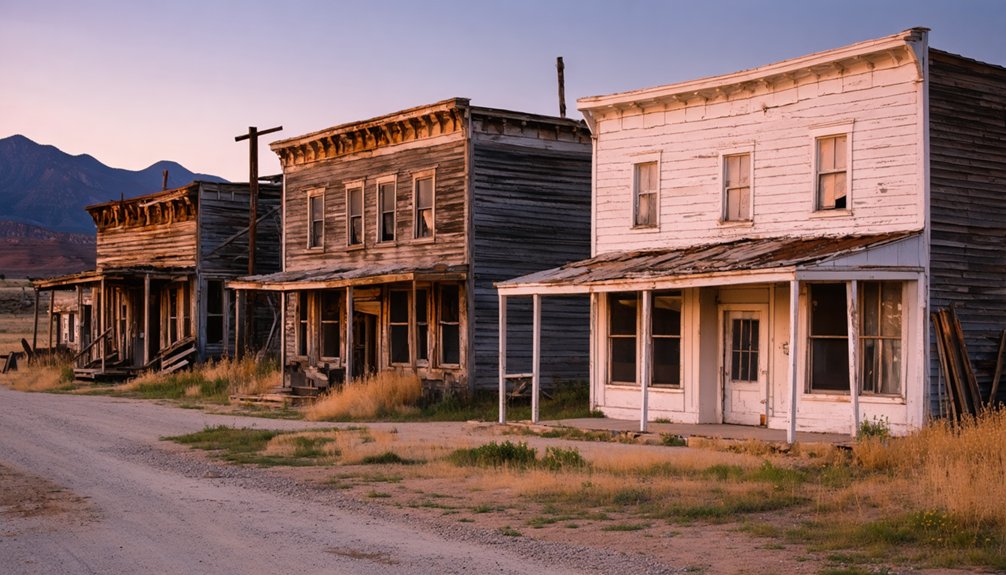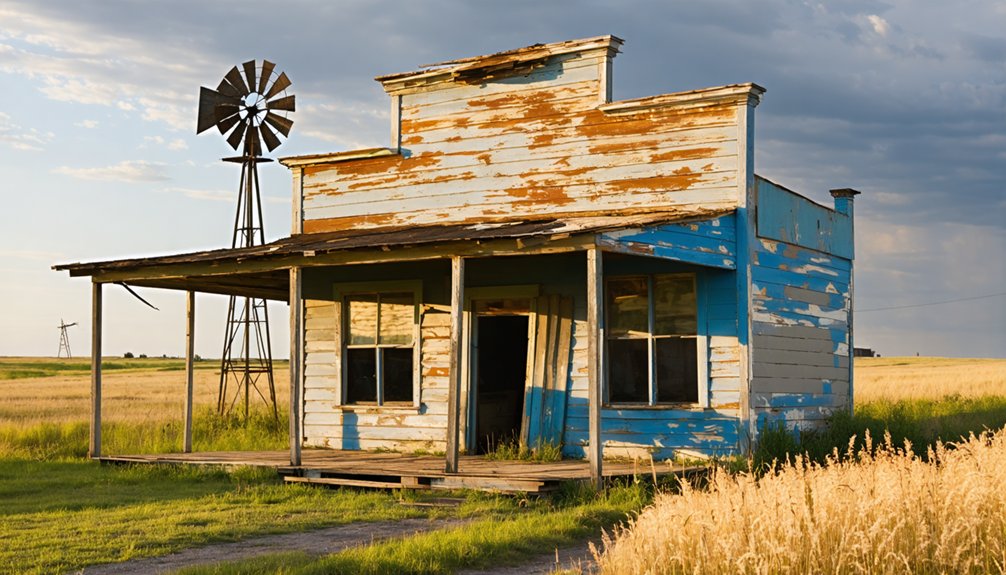You’ll find Buena Vista’s weathered stone ruins nestled in South Dakota’s Black Hills, where a bustling grindstone industry once thrived in the 1890s. The ghost town’s remains include quarry sites, factory foundations, and railroad infrastructure that shipped superior-quality grindstones across the region. While technological advances eventually made the town’s primary industry obsolete, the site’s archaeological treasures, from immigrant stonework to industrial artifacts, reveal fascinating layers of frontier innovation and cultural heritage.
Key Takeaways
- Buena Vista emerged as an industrial town in the 1890s, centered around a successful grindstone quarry operation in South Dakota’s Black Hills.
- The town thrived with nearly 50 businesses by 1883, supported by railroad connections and stone production facilities.
- Economic decline began when technological advances reduced grindstone demand and railroads bypassed the town, leading to population exodus.
- The site contains weathered grindstone remnants, ruins of stone structures, and historic foundations revealing the town’s industrial heritage.
- Buena Vista is among 600+ Black Hills ghost towns, now serving as a tourist destination with hiking trails and historical markers.
The Origins of a Grindstone Boomtown
While many Black Hills boomtowns emerged from gold or silver discoveries, Buena Vista’s origins stemmed from the development of a robust grindstone industry in the 1890s.
The Edgemont Land Company recognized the potential of the area’s rich sandstone deposits and established a thriving quarry operation that would transform the landscape. Like many ghost town remnants still visible today, traces of the original quarry can be found scattered across the site.
You’ll find evidence of the town’s ambitious beginnings in the infrastructure they built to support grindstone production. A dedicated factory, railroad spur, and stone hotel emerged to serve the growing workforce.
The quarry’s output wasn’t limited to local use – they shipped building blocks and grindstones to towns across South Dakota, Wyoming, and Nebraska. The high-quality sandstone proved ideal for both construction materials and grinding discs, establishing Buena Vista as a key supplier for regional development projects. Their grindstones gained widespread recognition when they were deemed superior to Bavarian stone in 1895.
Life in the Black Hills Mining Frontier
Long before Buena Vista’s grindstone industry took hold, the Black Hills mining frontier of the 1870s painted a vastly different picture of human settlement. You’d have found a diverse mix of fortune seekers rushing to stake their claims after the 1874 gold discovery, transforming untamed wilderness into bustling frontier communities like Deadwood and Lead.
The mining lifestyle was harsh and transient. You might’ve witnessed prospectors working placer deposits in creek beds or laboring in hard-rock mines, while entrepreneurs established saloons, general stores, and crude infrastructure to support the growing populations. The discovery of gold during Custer’s military expedition sparked this dramatic transformation of the region. By late 1875, four thousand illegal settlers had already flooded into the territory.
The social fabric wove together European immigrants, African Americans, and displaced Native Americans, though cultural tensions ran high. In these lawless camps, you’d have encountered legendary figures like Calamity Jane amid the daily struggle of frontier survival.
The Rise and Fall of Industrial Operations

As railroads carved through the Black Hills in the late 1870s, Buena Vista emerged as an essential industrial hub linking the Denver & Rio Grande and Denver, South Park & Pacific lines by 1880.
You’d find bustling lumberyards processing Ponderosa pine, while specialized Shay locomotives transported timber from remote hillsides to support the region’s voracious mining operations. The demand for lumber grew exponentially as sawmills proliferated throughout the area.
The town’s strategic position made it a crucial supply center for nearby mining districts, particularly Leadville, with businesses springing up to serve the influx of workers and rail crews. By 1883, the town boasted nearly 50 businesses catering to the growing industrial community.
But like many frontier boomtowns, Buena Vista couldn’t escape the cycle of industrial decline. As resource depletion hit both timber and mineral sectors, the once-thriving railroad hub gradually lost its economic foundation, leaving behind silent mills and empty rail yards as evidence of its industrial heritage.
Exploring the Remaining Stone Giants
As you walk through Buena Viste’s quiet quarries today, you’ll encounter massive grindstones and carved monoliths that tower as silent testimonies to the town’s industrial past.
These stone giants, weathered by time but still impressive in scale, showcase the skillful stonework and engineering capabilities that once defined this thriving settlement.
Like Mt. Rushmore, these quarries feature the distinctive Harney Peak granite that has made the Black Hills region famous for its monuments.
The remaining structures serve as open-air monuments to both the natural geology of South Dakota’s Black Hills and the human determination to shape these ancient rocks into tools of industry. Like other ghost town remnants across South Dakota, these structures provide a fascinating window into the region’s economic heritage.
Massive Grindstones Still Stand
The massive grindstones of Buena Vista stand as silent sentinels to South Dakota’s industrial past, dominating the landscape north of Edgemont in the Black Hills region.
You’ll find these remarkable stone wheels, crafted from local sandstone in the 1890s, scattered across their original quarry site. Some remain partially embedded in the native rock, while others stand free, their imposing size resembling prehistoric tractor wheels.
These monuments to grindstone craftsmanship showcase the quarrying techniques of their time, when workers used basic tools to extract and shape the durable sandstone. Like many barren sites in South Dakota, the quarry’s infrastructure has completely vanished. Like the collapsing church in Capa, these remnants tell stories of South Dakota’s abandoned past.
The stones’ incredible size and weight have protected them from removal or vandalism, allowing you to experience firsthand these impressive artifacts of the region’s industrial heritage.
They’re enduring symbols of the Black Hills’ rich quarrying history.
Industrial Heritage in Stone
Beyond the mammoth grindstones, Buena Vista’s industrial heritage lives on through an impressive collection of stone structures and architectural remnants.
You’ll discover how local stone craftsmanship adapted to the region’s timber scarcity, with builders utilizing abundant sandstone for everything from blacksmith shops to mining facilities. These surviving structures showcase remarkable architectural resilience, having weathered decades of Black Hills extremes.
The town’s industrial backbone reveals itself through utilitarian stone buildings that once served as assay offices, storage facilities, and railway infrastructure.
You can trace the town’s economic history through remaining lime kilns, quarry sites, and mining-related foundations. Each stone edifice tells a story of adaptation and ingenuity, where local materials shaped both the town’s physical appearance and its industrial capabilities.
Quarry’s Silent Stone Sentinels
Standing like geological monuments, massive quartzite and chalkstone formations dominate Buena Vista’s historic quarry landscape.
You’ll find these stone giants exhibiting distinctive reddish hues that fade from base to summit, showcasing the region’s geological significance through their composition of metamorphosed sandstone and Niobrara Formation chalkstone.
These silent sentinels, too massive for removal, tell the story of immigrant stone craftsmanship and industrial heritage.
They’re remnants of an era when 15-30 workers labored to extract and shape stone for the region’s building needs.
As you explore the quarry site, you’ll discover how these formations have withstood time’s passage, their weathered surfaces revealing the careful work of Czech and Russo-German stoneworkers who transformed this rugged terrain into a thriving industrial center.
Ghost Town Tourism and Historical Legacy
Located in the heart of South Dakota’s Black Hills region, Buena Vista represents one of over 600 ghost towns that paint a vivid picture of the area’s rich historical tapestry.
When you visit these abandoned settlements, you’ll discover how ghost town tourism creates a unique bridge between past and present, offering you a tangible connection to the region’s pioneering spirit.
You can explore former railroad grades transformed into hiking trails, examine historical plaques, and visit preserved grave sites that tell stories of early settlers.
At some locations, like Rockerville’s Gaslight Restaurant, you’ll find active businesses that blend historical charm with modern amenities.
The tourism impact extends beyond mere sightseeing – it contributes considerably to local economies while preserving essential pieces of South Dakota’s heritage for future generations to experience.
Economic Forces Behind the Abandonment

You’ll find that Buena Vista’s economic downfall began when technological advancements reduced the demand for traditional grindstones in mining operations.
The town’s supply chain crumbled as the railroad system, once essential for transporting heavy quarry products, bypassed the settlement in favor of more profitable routes.
Without its primary industry or reliable transportation networks, Buena Vista couldn’t sustain its workforce, leading to a swift population exodus that transformed this once-bustling quarry town into a ghost town.
Mining Demand Disappeared
While the Black Hills gold rush initially fueled Buena Vista’s rapid growth, several economic forces converged by 1880 to diminish mining demand and seal the town’s fate.
Mining innovations couldn’t overcome the depletion of high-grade ore deposits, while economic shifts favored larger operations like the Homestake Mine in Lead.
You’ll find that processing complex refractory gold became too expensive for most local mines to remain profitable.
- Placer gold deposits dried up quickly, forcing costly changes to hard rock mining
- George Hearst’s aggressive consolidation of mining claims squeezed out smaller operators
- Advanced processing methods like chlorination and smelting made operations too expensive
- Competition from silver mining towns like Leadville drew away vital investment capital
These combined forces made it impossible for Buena Vista’s mines to sustain commercial operations, leading to their eventual closure.
Supply Chain Collapse
The collapse of Buena Vista’s supply chains accelerated the town’s demise beyond the mining industry’s decline.
You’ll find that shifting transportation dynamics dealt the first blow, as trucking routes bypassed the once-vital rail town, severing its connection to broader markets.
The supply chain dynamics grew increasingly fragile as supporting industries crumbled – from grindstone manufacturing to basic merchant services.
Economic isolation intensified when the town’s infrastructure began to decay.
You couldn’t sustain local commerce as businesses shuttered, forcing residents to rely on distant suppliers at higher costs.
The town’s failure to diversify beyond its traditional industries proved fatal.
Without access to reliable transportation networks or alternative economic opportunities, Buena Vista’s remaining supply chains disintegrated, leaving the town unable to sustain itself.
Preservation Status and Archaeological Value
Located in South Dakota’s historic Black Hills region, Buena Vista ghost town persists primarily through its weathered grindstone remnants, which have resisted both vandalism and removal efforts over time.
While preservation challenges have led to the deterioration of most structures, the site maintains significant archaeological significance through its industrial ruins and settlement patterns.
Time may have claimed the buildings, but Buena Vista’s scattered ruins speak volumes about frontier industry and community life.
- Ruined cabin foundations peek through overgrown vegetation, telling stories of frontier life
- Scattered ash heaps reveal the daily activities of early settlers
- Weather-worn grindstones stand as silent sentinels to the town’s industrial heritage
- Hidden coal and coke production sites dot the surrounding landscape
You’ll find opportunities for archaeological research using modern techniques like ground-penetrating radar, which could uncover more secrets about this reflection of America’s industrial past while maneuvering the site’s accessibility challenges.
Regional Impact on Black Hills Development

During its heyday, Buena Vista played a pivotal role in shaping regional development across the Black Hills, establishing patterns that continue to influence modern economic and environmental challenges.
You’ll find that the town’s mining legacy mirrors today’s ongoing debates about balancing economic growth with environmental sustainability in the region.
Like many historic Black Hills settlements, Buena Vista’s boom-and-bust cycle offers valuable lessons for current development strategies, particularly regarding water management and land use planning.
The town’s history reflects broader regional challenges that persist today, including economic diversification beyond resource extraction and tourism.
As you explore the site, you’ll notice how past development choices continue to impact modern infrastructure needs and environmental conservation efforts throughout the Black Hills region.
Frequently Asked Questions
What Specific Types of Grindstones Were Manufactured at Buena Vista?
You’ll find limited information about specific grindstone types manufactured there, though based on the high-grade sandstone quarried, they’d have likely produced general-purpose industrial and agricultural grinding wheels.
How Many People Lived in Buena Vista During Its Peak Population?
Like footprints in shifting sand, the peak demographics of this town remain elusive. You won’t find exact population figures, as historical records don’t provide specific data about its historical significance.
Were Any Notable Accidents or Disasters Recorded in the Town’s History?
You won’t find documented mining accidents or major disasters in Buena Vista’s history. Unlike other Black Hills towns, there aren’t even ghost stories about catastrophic events affecting this grindstone-producing community.
What Was the Average Wage for Workers in Buena Vista’s Quarries?
You’d find quarry laborers earning around $30 monthly, similar to CCC workers of the 1930s. Wage history suggests Buena Vista’s quarry labor rates aligned with regional mining jobs’ typical $20-$50 monthly pay.
Did Any Famous Historical Figures Visit or Have Connections to Buena Vista?
You won’t find records of famous visitors or historical connections to Buena Vista. Unlike other Black Hills towns that attracted frontier personalities, this industrial town focused solely on grindstone production.
References
- https://www.sdpb.org/rural-life-and-history/2023-08-21/some-black-hills-ghost-towns-and-their-origins
- https://www.youtube.com/watch?v=Glucs_Rq8Xs
- https://www.sdhspress.com/journal/south-dakota-history-2-2/some-black-hills-ghost-towns-and-their-origins/vol-02-no-2-some-black-hills-ghost-towns-and-their-origins.pdf
- https://www.youtube.com/watch?v=_0WNYsFLSLA
- https://www.powderhouselodge.com/black-hills-attractions/fun-attractions/ghost-towns-of-western-south-dakota/
- https://www.geotab.com/ghost-towns/
- https://en.wikipedia.org/wiki/List_of_ghost_towns_in_South_Dakota
- https://icatchshadows.com/okaton-and-cottonwood-a-photographic-visit-to-two-south-dakota-ghost-towns/
- https://www.sdpb.org/rural-life-and-history/2022-06-22/grindstones-of-edgemont
- https://archive.org/download/glimpsesintoedge00tayl/glimpsesintoedge00tayl.pdf



